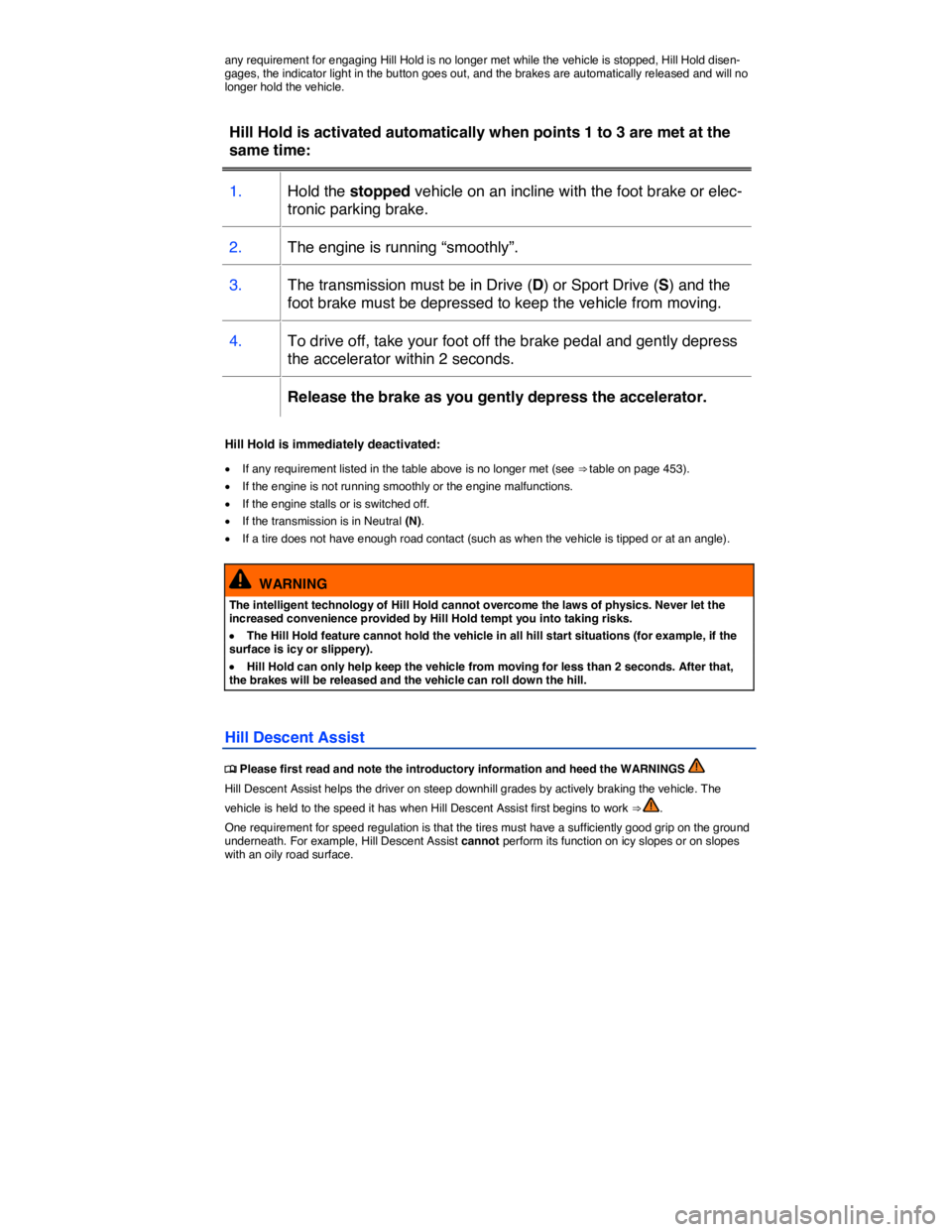2017 VOLKSWAGEN TOUAREG brakes
[x] Cancel search: brakesPage 421 of 684

fast cornering. XDL applies enough brake pressure to this wheel in order to stop the slippage. This improves traction, which helps the vehicle stay on track.
WARNING
Driving fast on icy, slippery, or wet roads can lead to a loss of control and result in serious personal injury for you and your passengers.
�x Always adjust your speed and driving style to road, traffic, weather, and visibility condi-tions. Never let the additional safety that ESC, ABS, BAS, ASR, and EDL can provide tempt you into taking extra risks.
�x Braking assistance systems cannot overcome the laws of physics and always prevent loss of vehicle control. Slippery and wet roads are still dangerous even with ESC and the other systems!
�x Driving too fast on wet roads can cause the wheels to lose contact with the road and “hy-droplane.” A vehicle that has lost road contact cannot be braked, steered, or controlled.
�x These systems cannot reduce the risk of accident, for example if you drive too fast for conditions or if you do not keep your distance from the vehicle in front of you.
�x Although these systems are very effective and can help you control the vehicle in many difficult situations, always remember that your vehicle handling control is limited by tire trac-tion.
�x When accelerating on a slippery surface, for example on ice and snow, depress the accel-erator carefully. Even with these systems, the wheels may start to spin, leading to a loss of vehicle control.
WARNING
The effectiveness of ESC can be significantly reduced if other components and systems that affect vehicle dynamics, including but not limited to brakes, tires, and other systems men-tioned above, are not properly maintained or functioning.
�x Always remember that vehicle alterations or modifications can affect the functioning of the ABS, BAS, ASR, EDL, and ESC systems.
�x Changing the vehicle suspension or using an unapproved tire / wheel combination can change the way the ABS, BAS, ASR, EDL, ASR, and ESC systems work and reduce their ef-fectiveness.
�x The effectiveness of ESC is also determined by the tires fitted ⇒ page 175, Tires and wheels.
All 4 wheels must be equipped with identical tires in order for ESC and ASR to work properly. Differences in the tread circumference of the tires can cause the system to reduce the engine power when it is not expected.
If ABS is not working, ESC, ASR, and EDL will also not work.
You may hear noises when these systems are active.
Page 423 of 684

mance, increases stopping distances and can even cause total brake failure. Your safety and the
safety of others depends on brakes that are working properly at all times ⇒ .
Brake fluid specifications
Volkswagen has developed a special brake fluid that is optimized for the brake system in your Volkswagen. Volkswagen recommends that you expressly use brake fluid that conforms to quality standard VW Standard 501 14 for optimum performance of the brake system. Check the information on the container for the brake fluid you want to use to make sure it meets the requirements for your vehicle.
Brake fluid that complies with VW Standard 501 14 can be purchased from your authorized Volkswagen dealer or authorized Volkswagen Service Facility.
If this special brake fluid is not available you may – under these circumstances – use another high-quality brake fluid that complies with U.S. Federal Motor Vehicle Safety Standard (FMVSS) 116 DOT 4
⇒ .
Please note, however, that not all brake fluids that comply with U.S. Federal Motor Vehicle Safety Standard FMVSS 116 DOT 4 have the same chemical composition. Some of these brake fluids can contain chemicals that could, over time, degrade or damage internal parts of the vehicle’s brake sys-tem.
Volkswagen therefore recommends that you use brake fluid that expressly complies with VW Stand-ard 501 14 for optimum brake system performance over the long term.
Brake fluid level
The fluid level in the transparent brake fluid reservoir must always be between the MIN and MAX
marking ⇒ .
On some vehicles, engine components block the view of the brake fluid reservoir and make it impossi-ble to see the brake fluid level. If you cannot clearly see the brake fluid level in the brake fluid reser-voir, please see an authorized Volkswagen dealer or authorized Volkswagen Service Facility.
The brake fluid level drops slightly when the vehicle is being used as the brake pads wear and the brakes are automatically adjusted.
Changing brake fluid
Brake fluid must be changed according to the service schedule in your ⇒ Booklet Warranty and
Maintenance. Have the brake fluid checked by an authorized Volkswagen dealer or an authorized Volkswagen Service Facility. Refill only with new brake fluid that meets the standards listed above.
WARNING
Brake failure and reduced brake performance can be caused by not having enough brake fluid in the reservoir or by old or incorrect brake fluid.
�x Check the brake system and brake fluid level regularly.
�x Always change the brake fluid according to the service schedule in your
⇒ Booklet Warranty and Maintenance.
�x Hard braking with old brake fluid may cause vapor lock. Vapor lock reduces braking per-formance, increases stopping distances and can even cause total brake failure.
�x Always make sure that only the correct brake fluid is used. Only use brake fluid that ex-pressly conforms to VW Standard 501 14 or, if it is not available, only use a high-quality brake fluid that conforms to U.S. Standard FMVSS 116 DOT 4 requirements.
�x Using another brake fluid, or one that is not of high quality, can impair the function of the brake system and reduce its effectiveness. If the container does not say that the brake fluid complies with VW Standard 501 14, or U.S. Standard FMVSS 116 DOT 4, do not use it.
�x The brake fluid must be new.
Page 443 of 684

This depends on vehicle conditions of the hybrid drive system is normal and is designed to save fuel. The power steering and the braking assistance systems remain active. In certain situations it may be necessary for the system to start the combustion engine even when the vehicle is not moving. With prolonged driving in traffic jams, the combustion engine will be switched on and off to charge the high-voltage battery for the following start-stop phase.
Sailing
If the accelerator is not depressed and the lever is in Drive (D), the internal combustion engine is switched off even at higher speeds. The vehicle then decelerates slower than conventional vehicles.
This feature can be used to help reduce fuel consumption when you keep traffic conditions in mind and can anticipate the vehicles power requirements. Even in this case, the rev counter in the instru-ment cluster displays zero engine speed (0 engine revolutions). The instrument cluster powermeter shows zero.
Brake energy regeneration (Recuperation/charge)
When the vehicle brakes, the electrical energy is generated by the electric motor, which works as an alternator and charges the high-voltage battery. The same thing occurs while the vehicle is coasting to a stop or driving downhill.
Energy regeneration is shown in the instrument cluster display or on the Infotainment System screen. The combustion engine may be switched off automatically in this situation. The instrument cluster powermeter registers below zero.
When the high voltage battery is fully charged, there is no brake energy recuperation, and therefore no engine braking. Recuperation and engine braking are also automatically reduced if the vehicle detects that the road conditions do not permit sufficient contact between the wheels and the road surface.
Automatic starting - combustion engine
The combustion engine is started automatically in a number of situations.
�x Engine temperature is too low.
�x Catalytic converter temperature is too low.
�x High-voltage battery being charged at high rate when decelerating. The high-voltage battery can-not absorb any more energy and for this reason the electric motor cannot brake the vehicle. The combustion engine comes on to help slow the vehicle down (engine brake).
�x Engine hood is open.
�x Leaving the vehicle when the electric motor is still “live”. The status of the electric motor is not always obvious, particularly when the combustion engine is not running. The combustion engine will therefore start if the driver's safety belt is unlatched or the driver's door is opened when the transmis-
sion is in Park (P) or Neutral (N) ⇒ Warning when leaving the vehicle.
Page 449 of 684

any requirement for engaging Hill Hold is no longer met while the vehicle is stopped, Hill Hold disen-gages, the indicator light in the button goes out, and the brakes are automatically released and will no longer hold the vehicle.
Hill Hold is activated automatically when points 1 to 3 are met at the
same time:
1. Hold the stopped vehicle on an incline with the foot brake or elec-
tronic parking brake.
2. The engine is running “smoothly”.
3. The transmission must be in Drive (D) or Sport Drive (S) and the
foot brake must be depressed to keep the vehicle from moving.
4. To drive off, take your foot off the brake pedal and gently depress
the accelerator within 2 seconds.
Release the brake as you gently depress the accelerator.
Hill Hold is immediately deactivated:
�x If any requirement listed in the table above is no longer met (see ⇒ table on page 453).
�x If the engine is not running smoothly or the engine malfunctions.
�x If the engine stalls or is switched off.
�x If the transmission is in Neutral (N).
�x If a tire does not have enough road contact (such as when the vehicle is tipped or at an angle).
WARNING
The intelligent technology of Hill Hold cannot overcome the laws of physics. Never let the increased convenience provided by Hill Hold tempt you into taking risks.
�x The Hill Hold feature cannot hold the vehicle in all hill start situations (for example, if the surface is icy or slippery).
�x Hill Hold can only help keep the vehicle from moving for less than 2 seconds. After that, the brakes will be released and the vehicle can roll down the hill.
Hill Descent Assist
�
Page 450 of 684

An indicator light �k comes on in the instrument cluster display whenever Hill Descent Assist is ena-bled. The indicator light blinks when Hill Descent Assist is regulating the brakes.
Hill Descent Assist is always enabled, but only regulates the brakes when certain requirements are met.
Hill Descent Assist regulates automatically:
�x If the vehicle is in off-road mode and the indicator light �k is on.
�x And: If your speed is under 18 mph (30 km/h).
�x And: If the downhill grade is 10 % or steeper.
�x And: If you neither accelerate nor apply the brakes.
�x And: If the vehicle's engine is running.
If you accelerate or step on the brake when Hill Descent Assist is operating, the feature switches off. Hill Descent Assist begins regulating speed again the next time the requirements are met.
Hill Descent Assist does not regulate speed:
�x On downhill grades of less than 10 %.
�x OR: At speeds over 18 mph (30 km/h).
�x OR: If the driver brakes or accelerates.
WARNING
Always be ready to apply the brakes. Otherwise accidents and injuries can occur.
�x Hill Descent Assist is merely a driving aid and cannot always slow the vehicle down enough under on downhill grades.
�x The vehicle may pick up speed despite the use of Hill Descent Assist.
The Hill Descent Assist also works when you are backing down a hill.
Page 454 of 684

WARNING
Always remember that the Adaptive Cruise Control has limits – Using Adaptive Cruise Con-trol when it is not possible to drive safely at a constant speed can be dangerous and can lead to an accident and serious personal injury.
�x Adaptive Cruise Control will not slow the vehicle down or maintain the set distance when you drive towards an obstacle or something on or near the road that is not moving, such as vehicles stopped in a traffic jam, a stalled or disabled vehicle.
�x Always adjust your speed and the distance you keep between you and the vehicles ahead of you to the road, traffic, weather, and visibility conditions.
�x Never use Adaptive Cruise Control on steep, winding, or slippery roads (such gravel roads, wet roads, or snowy or icy roads) or on roads with standing water.
�x Never use Adaptive Cruise Control when driving in heavy or varying stop-and-go traffic.
�x Never use Adaptive Cruise Control when driving off-road or on unpaved roads.
�x Always remember that the Adaptive Cruise Control cannot detect a vehicle that is driving towards you in your traffic lane and that it cannot detect narrow vehicles such as motorcy-cles and bicycles.
�x Never follow a vehicle so closely that you cannot stop your vehicle safely. The Adaptive Cruise Control cannot slow or brake the vehicle safely when you follow another vehicle too closely. Always remember that the Adaptive Cruise Control has a braking power that is only about 30% of the vehicle's maximum braking ability, under certain circumstances the auto-matic braking function cannot bring the vehicle to a stop in time.
�x Always turn off Adaptive Cruise Control when entering turn lanes, exit lanes and construc-tion zones or in similar situations because the vehicle will automatically accelerate to the stored speed when the road ahead is clear.
�x To help prevent unintended operation of Adaptive Cruise Control, switch the system off when it is not being used.
�x It is dangerous to use the Resume feature when the previously set speed is too high for the existing road, traffic, or weather conditions.
�x When traveling downhill, the Adaptive Cruise Control may not be able to maintain a con-stant speed. The vehicle will speed up because of its own weight. Downshift and/or use the foot brake to slow the vehicle.
�x Never allow the closing speed between you and other vehicles to be so high that the Adaptive Cruise Control may not be able to slow your vehicle safely. If closing speed is too high, you must apply the brakes yourself to reduce the risk of a rear-end crash.
�x If a driver intervention warning appears in the instrument cluster display, immediately takeover the control of the brake and gas pedals and low down the vehicle or bring it to stop when necessary and according to the traffic situation.
�x If a Forward Collision Warning system (Front Assist) collision warning appears in the instrument cluster display, immediately takeover the control of the brake and gas pedals and low down the vehicle or bring it to stop when necessary and according to the traffic situation.
�x Always be prepared to takeover the control of the brake and the gas pedal in every situa-tion.
NOTICE
If you suspect that ACC and the Forward Collision Warning system (Front Assist) don't work properly or the sensors are damaged, switch off ACC immediately.
�x Go see an authorized Volkswagen dealer or Volkswagen Service Facility for assistance and have the ACC system checked.
Page 464 of 684

WARNING
Improper use of the Adaptive Cruise Control can cause collisions, other accidents and seri-ous personal injury.
�x Always remember that the Adaptive Cruise Control has limits – it will not slow the vehicle down or maintain the set distance when you drive towards an obstacle or something on or near the road that is not moving, such as vehicles stopped in a traffic jam, a stalled or disa-bled vehicle.
�x Always remember that the Adaptive Cruise Control cannot detect a vehicle that is driving towards you in your traffic lane and that it cannot detect narrow vehicles such as motorcy-cles and bicycles.
�x Never drive at speeds that are too fast for traffic, road and weather conditions.
�x Never follow a vehicle so closely that you cannot stop your vehicle safely. The Adaptive Cruise Control cannot slow or brake the vehicle safely when you follow another vehicle too closely. Always remember that the Adaptive Cruise Control has a braking power that is only about 30% of the vehicle's maximum braking ability, the automatic braking function cannot bring the vehicle to a stop.
�x Never use Adaptive Cruise Control when you cannot drive safely at a steady speed, in-cluding on city streets, on winding roads or when road conditions are poor (for example, on ice, gravel, in fog, heavy rain or on wet roads that increase the risk of hydroplaning).
�x The radar sensor's vision can be reduced by rain, snow and heavy road spray. These and similar conditions can prevent vehicles up ahead from being accurately detected and in some cases they may not be detected at all. Do not use ACC when the radar sensors cannot accu-rately detect vehicles moving ahead of you in traffic.
�x Always turn off Adaptive Cruise Control when entering turn lanes, exit lanes and construc-tion zones or in similar situations because the vehicle will automatically accelerate to the stored speed when the road ahead is clear.
�x Never rest your foot on the accelerator pedal, especially when the Adaptive Cruise Control is being used because doing so will override the braking function.
�x Always pay attention to traffic, especially when Adaptive Cruise Control is switched on.
�x Always maintain a safe speed and distance between your vehicle and other vehicles while considering the traffic situation. This is the duty of the driver. Adaptive Cruise Control is merely an aid to the driver.
�x To prevent unintended operation, always switch ACC off when it is not being used.
�x It is dangerous to use the “Resume” feature when the previously set speed is too high for existing road, traffic or weather conditions.
�x Always select a speed and distance to traffic ahead that is safe and appropriate under the prevailing traffic, road, weather and lighting conditions.
�x Never allow the closing speed between you and other vehicles to be so high that the Adaptive Cruise Control may not be able to slow your vehicle safely. If closing speed is too high, you must apply the brakes yourself to reduce the risk of a rear-end crash.
NOTICE
When the vehicle is driving at speeds lower than 20 mph (30 km/h) and the �3�%�4 button is pressed or the lever is moved to �2�%�3�5�-�%, the vehicle will be accelerated to the lowest possible speed that can be set in ACC of 20 mph (30 km/h)
The stored speed is canceled when the ignition or the ACC is switched off.
Page 471 of 684

The Autonomous Emergency Braking function should be deactivated by switching off the Forward Collision Warning system (Front Assist) in following situations:
�x When the vehicle is being towed.
�x When the vehicle is on a roller test stand.
�x When the vehicle is off road, like on construction sites or on race tracks.
�x When one of the sensors is defect.
�x When the sensors have been damaged, like after a frontal collision accident.
�x After several false alarms in a row.
�x If the sensors are covered by additional parts, like auxiliary headlights.
�x If the vehicle is driving on steep terrain or on or across slopes.
WARNING
Always remember that the Autonomous Emergency Braking function has limits – it will not release you from the responsibility to control and slow down your vehicle.
�x The Autonomous Emergency Braking function alone cannot avoid accidents and fatal injuries.
�x Under certain circumstances and complex traffic situations the Autonomous Emergency Braking function can perform unwanted braking maneuvers, like in construction sites.
�x Soiled or misaligned radar sensors can lead to unwanted braking maneuvers
�x The Autonomous Emergency Braking function does not react to people, animals, crossing traffic or vehicles that are approaching you on the same lane.
�x Always adjust your speed and the distance you keep between you and the vehicles ahead of you to the road, traffic, weather, and visibility conditions.
�x Never follow a vehicle so closely that you cannot stop your vehicle safely, under certain circumstances the automatic braking function cannot bring the vehicle to a stop in time.
�x Never allow the closing speed between you and other vehicles to be so high that the Au-tonomous Emergency Braking function may not be able to slow your vehicle safely. If closing speed is too high, you must apply the brakes yourself to reduce the risk of a rear-end crash.
�x Always be prepared to takeover the control of the brake and the gas pedal in every situa-tion.
NOTICE
If you notice that the Autonomous Emergency Braking function doesn't work properly or the sensors are damaged, switch off the Forward Collision Warning system (Front Assist) and therefore the Autonomous Emergency Braking function immediately.
�x Go see an authorized Volkswagen dealer or Volkswagen Service Facility for assistance and have the system checked.
If the Autonomous Emergency Braking function initiates a braking maneuver, the hydraulic brak-ing system is under pressure. In this case the braking pedal will feel “harder” and the brake pedal travel will be shorter.
Automatic braking maneuvers can be interrupted by depressing the gas pedal or moving the steering wheel.
The Autonomous Emergency Braking function can slow your vehicle down to a standstill, but not hold your vehicle permanently. When necessary, apply the vehicle brakes!